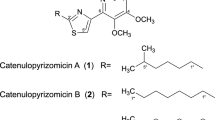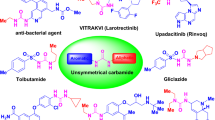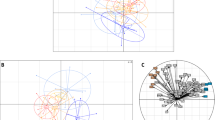Abstract
FR901459, a product of the fungus Stachybotrys chartarum No. 19392, is a derivative of cyclosporin A (CsA) and a powerful immunosuppressant that binds cyclophilin. Recently, it was reported that CsA was effective against hepatitis C virus (HCV). However, FR901459 lacks active moieties, which are essential for synthesizing more potent and safer derivatives of this anti-HCV agent. Here we identified an actinomycete strain (designated 7887) that was capable of efficient bioconversion of FR901459. Structural elucidation of the isolated bioconversion products (1–7) revealed that compounds 1–4 were mono-hydroxylated at the position of 1-MeBmt or 9-MeLeu, whereas compounds 5–7 were bis-hydroxylated at both positions. The results of morphological and chemical characterization, as well as phylogenetic analysis of 16S ribosomal DNA (rDNA), suggested that strain 7887 belonged to the genus Lentzea. Comparison of the FR901459 conversion activity of strain 7887 with several other Lentzea strains revealed that although all examined strains metabolized FR901459, strain 7887 had a characteristic profile with respect to bioconversion products. Taken together, these findings suggest that strain 7887 can be used to derivative FR901459 to produce a chemical template for further chemical modifications that may provide more effective and safer anti-HCV drugs.
Similar content being viewed by others
Log in or create a free account to read this content
Gain free access to this article, as well as selected content from this journal and more on nature.com
or
References
Hosobuchi, M., Kurosawa, K. & Yoshikawa, H. Application of computer to monitoring and control of fermentation process: Microbial conversion of ML-236B Na to pravastatin. Biotechnol. Bioeng. 42, 815–820 (1993).
Ueda, S. et al. Strain selection and scale-up fermentation for FR901379 acylase production by Streptomyces sp. no. 6907. J. Biosci. Bioeng. 112, 409–414 (2011).
Sasaki, J. et al. Transformation of vitamin D3 to 1α, 25-dihydroxyvitamine D3 via 25-hydroxyvitamine D3 using Amycolata sp. strains. Appl. Microbiol. Biotechnol. 38, 152–157 (1992).
Schulman, M., Doherty, P., Zink, D. & Arison, B. Microbial conversion of avermectins by Saccharopolyspora erthraea hydroxylation at C-27. J. Antibiot. 47, 372–375 (1994).
Nakagawa, K. & Torikata, A. Microbial conversion of milbemycins: 30-oxidation of milbemycin A4 and related compounds by Amycolatata autotrophica and amycolatopsis mediterranei. J. Antibiot. 43, 1321–1328 (1990).
Hall, R. M. et al. The production of novel sordarin analogues by transformation. J. Antibiot. 54, 948–957 (2001).
Kobayashi, M. et al. FR177391, a new anti-hyperlipidemic agent from Serratia. J. Antibiot. 58, 648–653 (2005).
Ho, S. et al. The mechanism of action of cyclosporin A and FK506. Clin. Immunol. Immunopathol. 80, S40–S45 (1996).
Watashi, K., Hijikata, M., Hosaka, M., Yamaji, M. & Shimotohno, K. Cyclosporin A suppresses replication of hepatitis C virus genome in cultured hepatocytes. Hepatology 38, 1282–1288 (2003).
Nakagawa, M. et al. Suppression of hepatitis C virus replication by cyclosporin a is mediated by blockade of cyclophilins. Gastroenterology 129, 1031–1041 (2005).
Inoue, K. et al. Combined interferon alpha2b and cyclosporin A in the treatment of chronic hepatitis C: controlled trial. J. Gastroenterol. 38, 567–572 (2003).
Membreno, E. E., Espinales, J. C. & Lawitz, E. J. Cyclophilin inhibitors for hepatitis C therapy. Clin. Liver Dis. 17, 129–139 (2013).
Sakamoto, K. et al. FR901459, a novel immunosuppressant isolated from Stachybotrys chartarum No. 19392. J. Antibiot. 46, 1788–1798 (1993).
Muramatsu, Y. et al. Neuroprotective efficacy of FR901459, a novel derivative of cyclosporin A, in in vitro mitochondrial damage and in vivo transient cerebral ischemia models. Brain Res. 1149, 181–190 (2007).
Yassin, A. F. et al. Lentzea gen. nov., a new genus of the order Actinomycetales. Int. J. Syst. Bacteriol. 45, 357–363 (1995).
Labeda, D. P., Hatano, K., Kroppenstedt, R. M. & Tamura, T. Revival of the genus Lentzea and proposal for Lechevalieria gen. nov. Int. J. Syst. Evol. Microbiol. 51, 1045–1050 (2001).
Xie, Q. et al. Description of Lentzea flaviverrucosa sp. nov. and transfer of the type strain of Saccharothrix aerocolonigenes subsp. staurosporea to Lentzea albida. Int. J. Syst. Evol. Microbiol. 52, 1815–1820 (2002).
Sasamura, S. et al. Bioconversion of AS1387392: screening and characterization of actinomycetes that convert AS1387392 to AS1429736. J. Antibiot. 63, 637–642 (2010).
Yamanaka, T. et al. Synthetic studies on anti-HCV agents via chemical transformation of cyclosporin analogues (2). The 31st Medicinal Chemistry Symp 1P-41 (The Pharmaceutical Society of Japan, Hiroshima, Japan, 2013).
Lee, S. D. et al. Saccharothrix violacea sp. nov., isolated from a gold mine cave, and Saccharothrix albidocapillata comb. nov. Int. J. Syst. Evol. Microbiol. 50, 1315–1323 (2000).
Takeuchi, T. et al. Real-time detection system for quantification of hepatitis C virus genome. Gastroenterology 116, 636–642 (1999).
Lohmann, V. et al. Replication of subgenomic hepatitis C virus RNAs in a hepatoma cell line. Science 285, 110–113 (1999).
Kishine, H. et al. Subgenomic replicon derived from a cell line infected with the hepatitis C virus. Biochem. Biophys. Res. Commun. 293, 993–999 (2002).
Hamada, M. Identification Manual of Actinomycetes (in Japanese), (ed.The Society for Actinomycetes Japan) 37–47 (Business Center for Academic Societies Japan, Tokyo, Japan, 2001).
Pridham, T. G. & Gottlieb, D. The utilization of carbon compounds by some Actinomycetales as an acid for species determination. J. Bacteriol. 56, 107–114 (1948).
Kornerup, A. & Wanscher, J. H. Methuen Handbook of Colour (Methuen, London, 1978).
Suzuki, K. & Kudo, T. Identification Manual of Actinomycetes. (in Japanese), (ed. The Society for Actinomycetes Japan) 49–82 (Business Center for Academic Societies Japan, Tokyo, Japan, 2001).
Becker, B., Lechevalier, M. P., Gordon, R. E. & Lechevalier, H. A. Rapid differentiation between Nocardia and Streptomyces by paper chromatography of whole-cell hydrolysates. Appl. Microbiol 12, 421–423 (1964).
Nakagawa, Y. & Kawasaki, H. Identification Manual of Actinomycetes (in Japanese), (ed. The Society for Actinomycetes Japan) 83–117 (Business Center for Academic Societies Japan, Tokyo, Japan, 2001).
Thompson, J. D., Higgins, D. G. & Gibson, T. J. CLUSTAL W improving the sensitivity of progressive multiple sequence alignment through sequence weighting, position-specific gap penalties and weight matrix choice. Nucleic Acids Res. 22, 4673–4680 (1994).
Acknowledgements
HCV replicon cells (#50-1) were kindly provided by Dr K Shimotohno (Kyoto University). We would like to thank Dr M Kohara (Tokyo Metropolitan Institute of Medical Science) for advising about quantification of the HCV genome. We also thank Dr Shigehiro Takase for suggestion and technical assistance with structure elucidation and Ms Mayumi Sodeyama for technical assistance with isolation of actinomycetes.
Author information
Authors and Affiliations
Corresponding author
Ethics declarations
Competing interests
The authors declare no conflict of interest.
Rights and permissions
About this article
Cite this article
Sasamura, S., Kobayashi, M., Muramatsu, H. et al. Bioconversion of FR901459, a novel derivative of cyclosporin A, by Lentzea sp. 7887. J Antibiot 68, 511–520 (2015). https://doi.org/10.1038/ja.2015.19
Received:
Revised:
Accepted:
Published:
Issue date:
DOI: https://doi.org/10.1038/ja.2015.19
This article is cited by
-
Cloning and heterologous expression of P450Lent4B11, a novel bacterial P450 gene, for hydroxylation of an antifungal agent sordaricin
The Journal of Antibiotics (2020)
-
Isolation and anti-HIV-1 integrase activity of lentzeosides A–F from extremotolerant lentzea sp. H45, a strain isolated from a high-altitude Atacama Desert soil
The Journal of Antibiotics (2017)
-
Lentzea chajnantorensis sp. nov., an actinobacterium from a very high altitude Cerro Chajnantor gravel soil in northern Chile
Antonie van Leeuwenhoek (2017)



